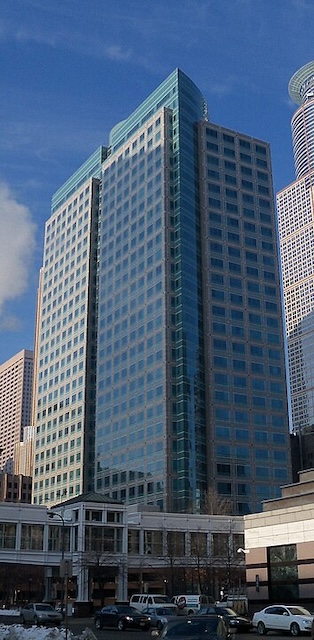A downtown Minneapolis office building that sold for $220 million in 2016 was resold last week for $6.25 million, a 97 percent markdown. The Ameripress Financial Center is a 31-story office building that was built in 2000 and occupied by a single tenant, the American Express Financial Advisors (which was spun off by American Express in 2005 and renamed Ameripress). The building had been leased by Ameripress, which has its own building in downtown Minneapolis, and with so many people working remotely, it moved out of the leased one.
Photo by AlexiusHoratius.
The Minneapolis Downtown Council keeps saying that downtown is recovering, but admits that that recovery is more in the nature of evening restaurant patronage than office workers. It recently released a 2035 recovery plan that relies heavily on government urban-renewal projects in sites such as the waterfront and former post office.
The buyers of the Ameripress building issued a press release last week that included a vague reference to the possibility of “converting all or some of the building to uses other than office,” such as residences. At last report, downtown Minneapolis office buildings have a 30 percent vacancy rate, but converting the Ameripress building to residences could be so expensive that it might make more sense to simply tear it down and start over.
Of course, even if it is converted to or replaced with residences doesn’t mean that anyone would want to live there, especially considering the high rents that would be needed to cover the costs of conversion or construction. The Biden administration would probably have been amenable to a federal subsidy to support a conversion, but the Trump administration won’t be.
In fact, at about the same time the Ameripress sale was announced, the Trump administration directed agencies in the Department of Transportation to “give preference to communities with marriage and birth rates higher than the national average” when handing out federal grants. The direction specifically called out transit capital grants, overturning the FTA preference for funding projects supported by high-density developments, not to mention FTA grants for such high-density “transit-oriented” developments themselves.
In general, high-rise and mid-rise housing doesn’t support high birth rates because such housing is so expensive to build that most of the dwelling units are too small to support families with children. Communities that want higher birthrates will need to promote more single-family homes, which means states like Oregon and Washington and counties like the ones surrounding San Francisco will need to abolish urban-growth boundaries.
Six and a quarter million dollars for a building that was previously worth $220 million is quite a steal, and the 97 percent markdown means that the buyer only needs to find tenants for 3 percent of the building or so to keep it open. But it also shows that investors, including those who previously owned the building, don’t have much faith in downtown recovery.









Even if these buildings were used for residences, where would the people work? Where would they shop? The only logic I can see with this is that who ever is behind these ideas wants lots of desperate low wage labor to work down town cleaning other building etc. Alternately, they might be thinking young single people will live their when they do their “professional” internships on summer break from college. Honestly, the policy makes little sense other than to feed into planner fantasies of density.
Culture especially religion plays a huge role in birth rates.
False. Level of economic development is generally considered the biggest predictor of birthrates.
That Ameripress building is kitty korner from a building part of the Northstar Center that was converted into the Groove Lofts. That building was built in the 1960s and smaller floor plan is much better suited for residences.
Ameriprise Financial Center was built right before the tech bubble burst. It’s a modern building with far larger floor plans. Harder to convert to residences unless you have a bunch of vampires to rent it out to.
Even if the cost of conversion wasn’t an issue, there are a limited number of people interested in living downtown and even less who can afford a two bedroom for what adds up to be $3k/ month ( rent, fees, parking ).
I’m not sure how much more of those sort of units down the market can support. Especially with so many of the downtown employers either leaving or not requiring regular travel into work. There’s a lot of places you could live, save $500 – $1000 / month, not be surrounded by concrete and still have nice amenities.